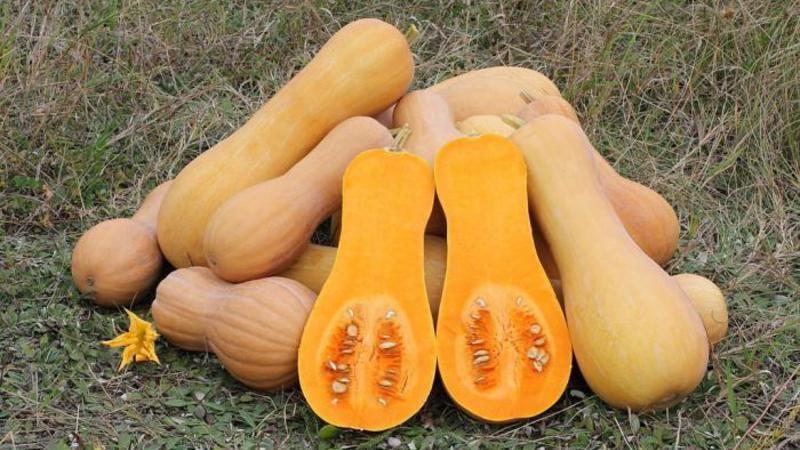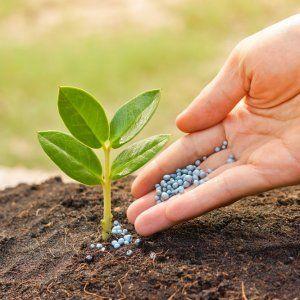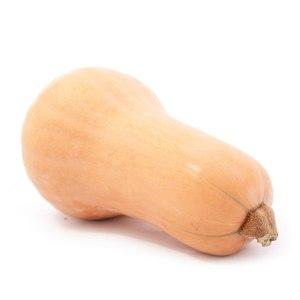Fragrant nutmeg pumpkin variety "Pearl": what is good and why it should be grown on your site
The pumpkin was brought to Russia in the 16th century by oriental merchants. The vegetable quickly gained popularity: people appreciated its unusual taste and unpretentious care. Over the centuries, culture has not lost its relevance, every year more and more of its different types appear.
One of the most popular is the Pearl variety. It is characterized by sweet and soft pulp, excellent aroma. From the article you will find out what else the Pearl is so fond of many gardeners.
The content of the article
Description of the variety
Pearl belongs to nutmeg varietieswhich get their name from their strong nutmeg aroma. The fruit has an elongated pear-shaped shape, and there are 5 edges on the cut of the stalk. The peculiarity of the variety is also visible on seeds: they are usually dark yellow or brown in color.
Interesting. Mexico is considered the birthplace of nutmeg varieties. Sometimes the weight of one pumpkin reaches 100 kg.

Distinctive features
The pearl is a medium late variety, the first harvest is harvested 110 days after planting. Vigorous plant with many leaves. They have the shape of a pentagon and are dark green in color.
The culture is thermophilic, so it is best to grow the Pearl in regions with fertile soil and temperate climates.
Fruit characteristics
The shape of the vegetable is cylindrical, but sometimes more rounded options are found. Due to the high content of carotene, the peel has a bright orange color. The skin is pliable, flexible and thin.
Pearl's pulp is sweet and juicy. The structure is crispy and tender. The average weight of one pumpkin is 8 kg. Length - about 50-70 cm. There are few seeds.
Yield
The yield is high; about 36 tons per hectare are harvested on an industrial scale. If we talk about growing on a garden plot, then gardeners get 15-20 kg per 1 sq.m.
The following factors affect the yield:
- Compatibility with previous cultures. The vegetable is not planted after cucumbers, squash, zucchini. It is best to plant the Pearl after potatoes, legumes, greens or cabbage.
- Variety and climatic zone compatibility. The Pearl variety gives the richest harvest in warm regions.
- Choosing a landing site. A sunny, spacious and windless area is allocated for the pumpkin. The soil should be loose, moist and fertile.
- Compliance with the rules of cultivation: regular watering, loosening the land, removing weeds and applying fertilizers.
How to grow
There are several ways to plant a crop. Let's consider each of them and identify the features.
Planting with seeds
 Planting with seeds is suitable for areas with favorable weather conditions and long daylight hours. In addition, the culture loves cleared areas, so the land is prepared in advance. To do this, the beds are cleared of weeds, debris and remnants of last year's plants, then they are dug up and loosened.
Planting with seeds is suitable for areas with favorable weather conditions and long daylight hours. In addition, the culture loves cleared areas, so the land is prepared in advance. To do this, the beds are cleared of weeds, debris and remnants of last year's plants, then they are dug up and loosened.
Sandy loam and loamy soil is excellent for pumpkin. This mixture retains moisture well and is quickly warmed up by the sun's rays.
The next stage of planting is the preparation of the seed. It is treated with disinfectants. For example, using a solution of sodium humate and water. The seeds are soaked in solution for 24 hours, after which they are left for two days in wet gauze.
The procedure destroys larvae and dangerous microorganisms on the surface of the seeds. The quality of seeds and their germination improves, the growth and development of plants is accelerated.
For landing, choose a calm, cloudy day. The distance between the seeds should be at least 80 cm. Place the seeds in the soil and water them abundantly.
Planting seedlings
 Experienced farmers advise germinating the seeds before planting. To do this, after processing, they are soaked for 3 hours in warm water. Then it is wrapped in damp gauze and placed in a warm place. Germination has a beneficial effect on the future harvest, reduces the risk of infections.
Experienced farmers advise germinating the seeds before planting. To do this, after processing, they are soaked for 3 hours in warm water. Then it is wrapped in damp gauze and placed in a warm place. Germination has a beneficial effect on the future harvest, reduces the risk of infections.
Then the seeds are hardened: they are placed in a freezer for 3 days. Next, there is a landing in open ground. For this, the land is preliminarily treated with phosphorus or mineral fertilizers. Manure, dung and compost are also excellent food for the earth.
Seedlings are sown in moist and warm soil. The distance between the beds is about 1.5-2 m. Each seedling is deepened into the hole by 9-10 cm.
The top layer of earth is sprinkled with humus no more than 2 cm thick. Otherwise, it will be difficult for the sprouts to break through the thick layer of humus. Cover the beds with foil to maintain optimal temperature conditions.
Important! The best time for planting seeds in open ground is the second half of May. Saplings are not afraid of frost, and the earth at this time is already warmed up and contains less moisture.
Care
First of all, the bush needs to be formed. As soon as the main stem reaches a height of 1.5 m, it is pinched. The main principle of formation is the removal of additional shoots. If this is not done, then many extra sprouts and small vegetables are formed. They cannot develop normally and die after a while.
Water the Pearl only with warm water (at least 20 degrees). It is best to use standing or rainwater, avoiding watering directly from the water supply. Abundant watering is contraindicated, as the green mass develops rapidly, and not the vegetables themselves.
Remember to remove weeds regularly. She feeds on pumpkin, thereby taking some of her vitamins and minerals. Especially a lot of weeds appear after rains and fogs. Also loosen the beds in a timely manner. Loosening saturates the earth with oxygen, makes it airy and nutritious. It is recommended to loosen the soil every 7-10 days.
Important! When growing, pay attention to the pumpkin whips. When they grow to one meter, untangle them and lay them down, sprinkling with earth on top. In places of powdering, the lashes take root and the plant receives additional nutrition. Plus, so the whips will not break under the influence of the wind.
Fertilizers
Fertilizers should be balanced and contain the optimal amount of vitamins and macronutrients.
To obtain a rich harvest, summer residents recommend using:
- Complex "Zdraven". It has a positive effect on the root system, making it more powerful and developed. In addition, "Zdraven" strengthens the pumpkin's immunity, protects against the effects of pests.
- The drug "Magic watering can" is a liquid top dressing. Increases plant immunity to adverse climatic conditions, stimulates the development of vegetables.
- Biohumus and humus - excellent organic feeding. Increase crop yield by 10-15%.
- Yeast and wood ash solution. In addition to nutrition, the solution will protect the pumpkin from spider mites and aphids.
- "Nutrivant Plus Pumpkin" is an environmentally friendly and safe product that improves the quality of vegetables.
Farmers advise feeding the pumpkin in 2 stages. The first feeding occurs when five true leaves appear, and the second at the stage of lash formation. During the ripening period, feeding with ash and mullein infusion is especially effective.
Features of cultivation and possible difficulties
 If the pearl turned out to be very large and heavy, then build a special stand for the pumpkin: put a wide board on several stones, on top of which put the vegetable. It is best to do this as early as possible so that the stem does not break under the weight of the pumpkin.
If the pearl turned out to be very large and heavy, then build a special stand for the pumpkin: put a wide board on several stones, on top of which put the vegetable. It is best to do this as early as possible so that the stem does not break under the weight of the pumpkin.
The wood ash top dressing described above will be more effective when dissolved in water. And dusting with dry ash will help protect the leaves from pests.
It is better to do this after watering or rains. If you are using growth stimulants or chemicals, follow the dosage recommendations and rules of use.
Important! Alternate mineral and organic fertilizers. For the first top dressing, liquid manure or herbal infusion is excellent. The infusion of nettle has a special value. For one vegetable, use 0.5 liters of infusion.
Tips from experienced gardeners
Here is what summer residents advise to get a richer and better harvest:
- Soak the butternut squash seeds in the formalin solution for 2 hours. Then dry them in the sun.
- Do not forget to harden the seed.
- Check seeds for germination.
- The best time for planting seeds is the first half of June.
- If the ovaries are small, then it is better not to water the pumpkin. Otherwise, the leaves and whips will grow large, and the vegetable itself will be small.
- Pearl is fed every two weeks.
- The beds should be on the sunny side.
Diseases and pests
 During the period of pumpkin growth, insect pests are activated.
During the period of pumpkin growth, insect pests are activated.
Especially often, gardeners in their beds meet:
- Medvedka. It destroys the roots of the plant, which is why the vegetable itself withers after a while. To fight the bear, gardeners use Medvedoks. The preparation in the form of granules is laid out in the wells in accordance with the recommendations.
- Aphids. She sucks juice from plants. Leaves and ovaries subsequently die. To combat it, use a soap solution that is sprayed on the bushes.
- Slime, due to which the ovaries and leaves also die. For prophylaxis, an ash solution is used.
In addition to pests, pumpkin is also negatively affected by diseases. The most common is bacteriosis. Brown sores appear on the vegetables, which cause damage to the pumpkin. Bacteriosis persists on seeds and plant debris. The disease develops rapidly with sudden changes in temperature and high humidity.
Also, the culture gets sick with root rot. The roots and stems acquire a brown hue, their growth stops. Rot can destroy a vegetable. The soil is the reservoir of infection. For prevention, it is advised to remove weeds on time, to maintain the required moisture level. To treat the disease, use a mixture of copper sulfate or Bordeaux liquid.
Harvesting and application of the crop
Harvesting of the nutmeg variety begins in mid to late September. If by this time the vegetable is not yet ripe, feel free to pick it anyway. The pumpkin will “reach” on its own, reaching its peak of maturity in 20-60 days. The pulp will become juicy and soft, it will turn into a bright orange color. When harvesting, cut the stalk so that about four centimeters remain on the vegetable.
Delicious dried and dried "tongues" are obtained from pumpkin. The dried product retains its taste, beneficial properties and vitamins. Dried pumpkin pairs well with powdered sugar and serves as a great snack when traveling. Rice milk porridge with the addition of pumpkin pieces is especially popular. The vegetable will not only add spice, but also decorate the dish.
Many housewives use pumpkin in cooking baked goods and muffins. For example, they make pumpkin pie with cinnamon, or bake pies from pumpkin and apples. Pumpkin cream soup is also popular and is served in restaurants around the world.
Advantages and disadvantages of the variety
The advantages of the Pearl include a rich harvest, excellent taste and sweet juicy pulp. The pumpkin keeps well and is resistant to long distance transportation.The plant rarely gets sick.
The disadvantages of the variety are its exactingness to the soil and growing conditions. That is why it is so important to pay special attention to feeding and fertilizing. Otherwise, the Pearl has no downsides.
Farmers reviews
Here's what gardeners say about the pearl on the Internet forums:
 Irina, Krasnodar Territory: “Every year I try to grow a new pumpkin variety. I planted a Pearl last season. I liked the variety very much, one of the most delicious. She looked after as usual, fertilized with droppings and ash. I advise everyone".
Irina, Krasnodar Territory: “Every year I try to grow a new pumpkin variety. I planted a Pearl last season. I liked the variety very much, one of the most delicious. She looked after as usual, fertilized with droppings and ash. I advise everyone".
Galina, Voronezh: “The pearl exceeded all my expectations. I don’t remember being able to grow such a rich harvest. All vegetables turned out to be beautiful, bright, the taste is excellent. Part of the harvest ripened in the cellar. The pearl turned out to be delicious filling for buns and jam ".
Elena, Kurgan region: “I heard a lot about the Pearl variety and decided to plant it. She planted it in seedlings, but in mid-July a bear attacked the vegetable. She got rid of her only after 10 days, during which time she managed to spoil part of the harvest. Those vegetables that we managed to save turned out to be juicy. I doubt that I will re-grow the pearl pumpkin. "
Conclusion
Pumpkin has many culinary advantages: it decorates dishes, adds piquancy and saturates the body with vitamins. In it, pulp, seeds, and juice are useful. A vegetable in cultivation is unpretentious, you can achieve a rich harvest if you follow the simplest rules.
Pumpkin Pearl belongs to the nutmeg varieties - they are sweeter, in contrast to the hard-bore varieties. She loves warmth and timely feeding. However, even in the mountains, gardeners get a good harvest of this variety. This pumpkin is not afraid of either drought or disease. Therefore, feel free to choose a Pearl for your garden!